No Knead Sourdough Dutch Oven Bread
This post may contain Amazon or other affiliate links. As an Amazon associate, I earn from qualifying purchases.
No Knead Sourdough Dutch Oven Bread is an easy way to make artisan-style crusty bread at home! The best part is, very little effort is needed and it’s foolproof! Anyone can make it. Just 5 minutes of mixing in the morning and you can have delicious homemade bread by dinner!
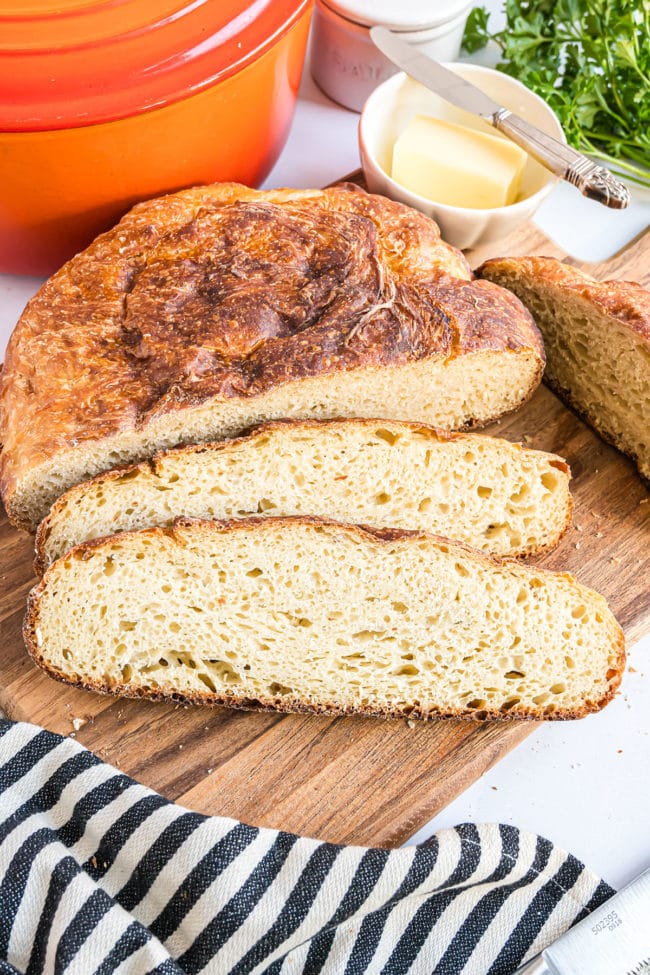
Table of Contents
Why We Love Artisan No-Knead Sourdough
Homemade sourdough bread doesn’t have to mean hours of preparation, kneading, proofing, folding, or worse, overnight waiting! Artisan sourdough bread in a Dutch oven recipe is the no-hassle way to homemade deliciousness. That’s just one of many reasons to fall in love…
- Minimal Effort – just one bowl and five minutes of prep and mix.
- Maximal Flavor – the unique combination of flour and tangy Greek yogurt provides a complex sourdough taste.
- Pantry Staples – basic pantry ingredients mean you control the quality of homemade sourdough artisan bread.
- No Knead – No “need” to worry about complex timing or special kneading technique.
- Versatile Enjoyment – From sandwiches to toast, our bread’s versatility ensures that every slice becomes a delightful part of many meals.
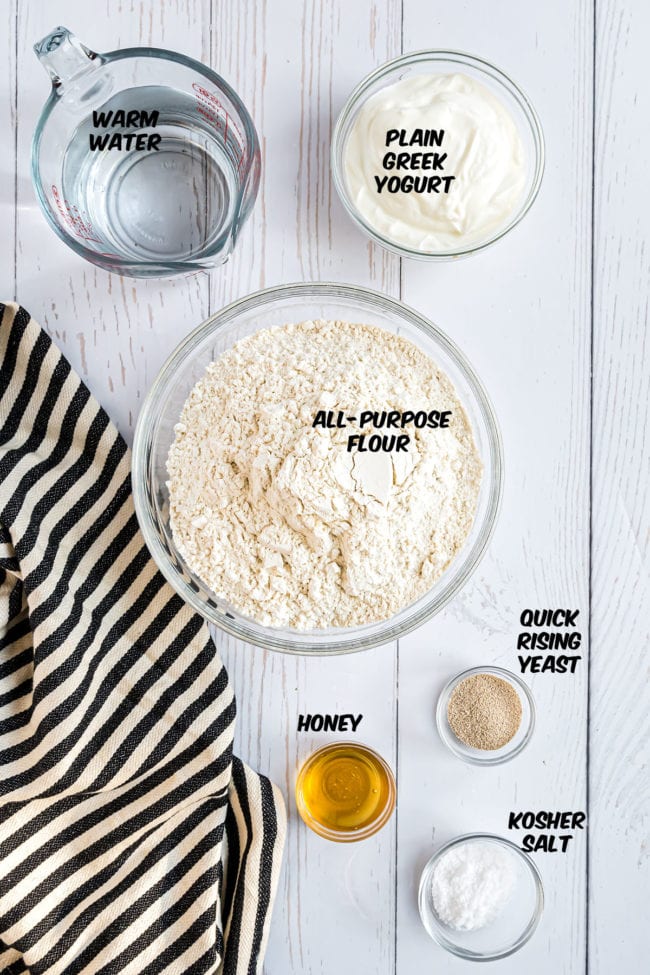
Dutch-Oven Sourdough Ingredients
Warm, fragrant, no-knead sourdough has never been easier!
For specific amounts, please refer to the printable recipe card at the bottom of the post.
- All-Purpose Flour
- Quick Rising Yeast – also known as instant yeast
- Kosher Salt
- Water – warm
- Greek Yogurt – plain, not flavored
- Honey
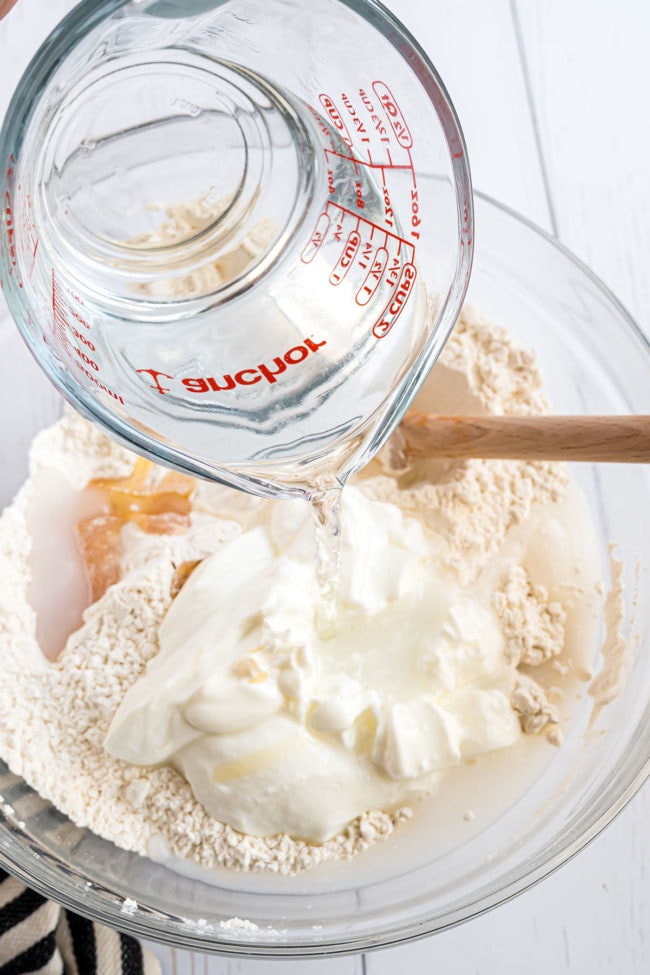
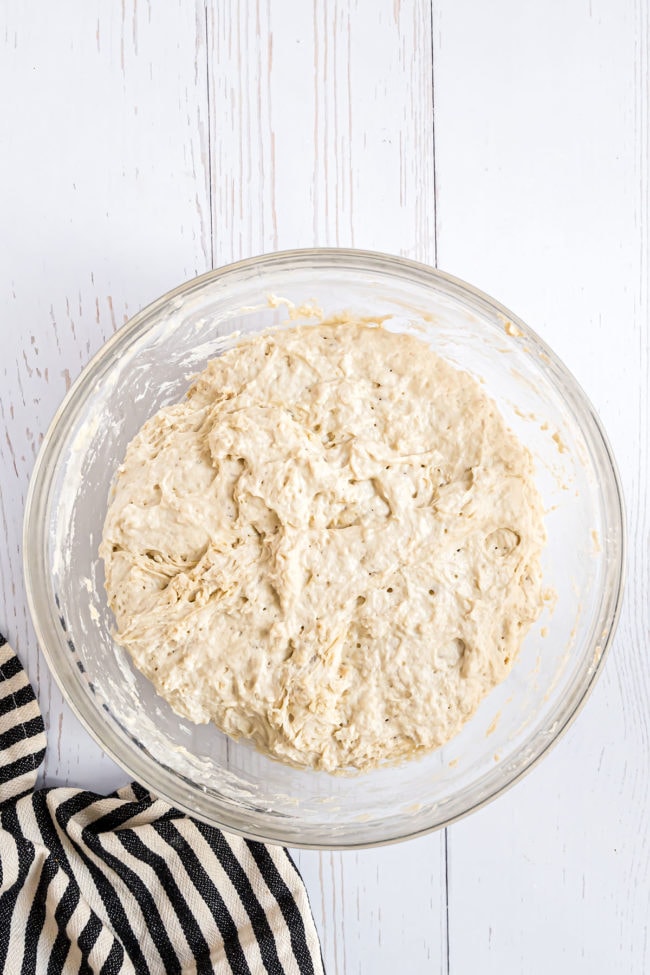
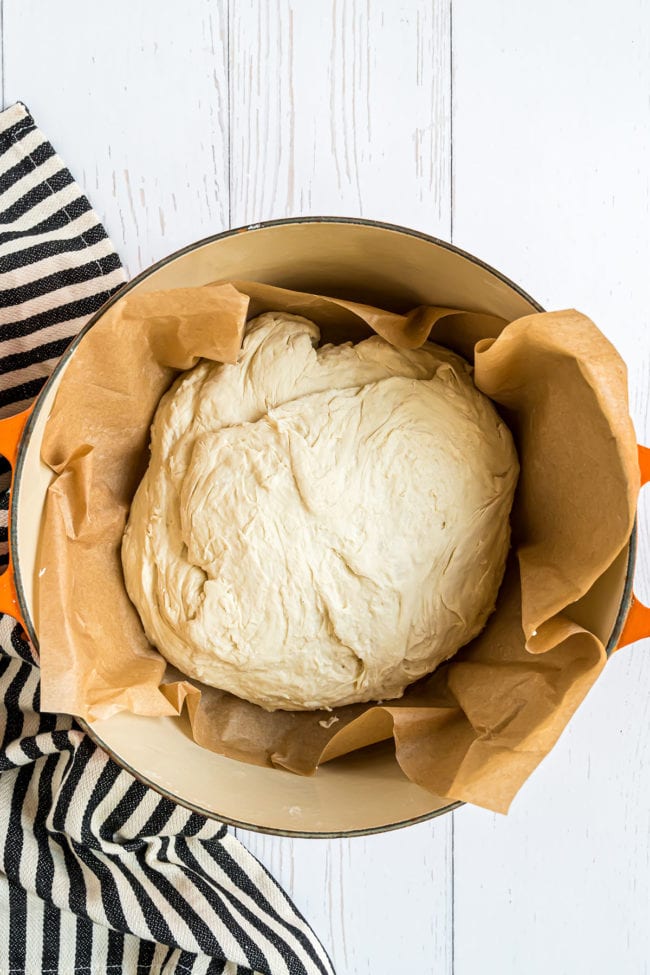
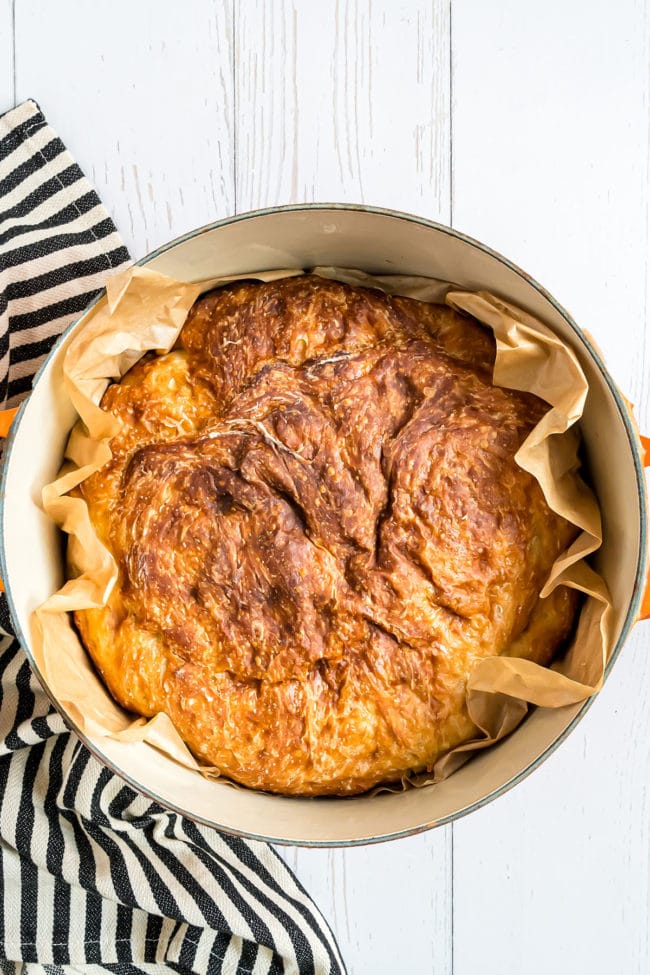
This post may contain affiliate links. Please read my disclosure policy here.
How To Bake Sourdough In A Dutch Oven
Get ready for the best one-bowl sourdough yogurt bread that doesn’t take all day or overnight proofing.
When you are making this recipe, you’ll want to use the full recipe at the bottom of the page.
Kitchen Tools:
- 3 qt to 5 qt Cast-Iron Dutch Oven
- Glass Mixing Bowl
- Wooden Spoon
- Parchment Paper (or) Silicon Sling
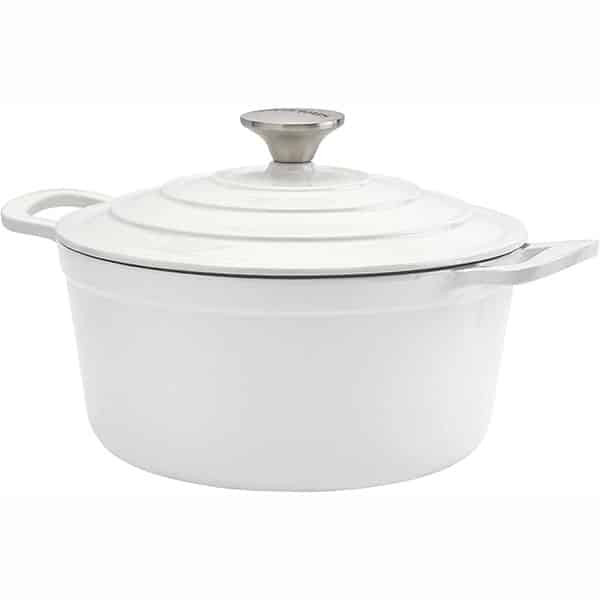
Featured Product White Dutch Oven
Durable cast iron construction delivers superior heat retention and ensures even cooking
Directions
- Combine Ingredients: Mix yeast, flour, salt, water, yogurt, and honey until well incorporated.
- Rise: Cover and let sourdough rise at room temperature* until it doubles.
- Shape and Rest: Form the dough into a ball on a floured surface and place it in a lined Dutch oven. Let it rest for an hour.
- Bake Covered: Bake in a covered Dutch oven at 475°F for 20-25 minutes.
- Uncover and Bake: Remove the cover and bake until golden brown.
- Cool: Remove the bread from the Dutch oven and let it cool completely on a rack for at least 1 hour before slicing. Enjoy your no-knead sourdough!
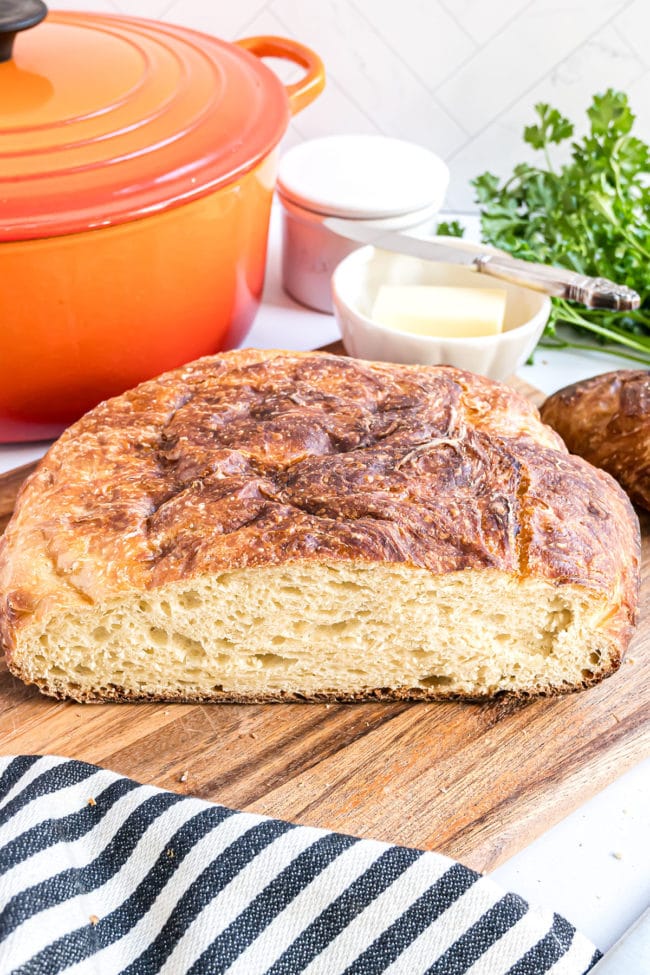
Dutch Oven Bread Recipe Notes & Tips
- If you don’t have a digital kitchen scale to measure flour (1 cup weighs 120 to 130 grams), whisk, then spoon flour into a measuring cup and level. This King Arthur video demonstrates perfectly how easily flour compacts, throwing off baking outcomes.
- Please be sure your yeast is not expired, as it provides the crucial leavening element for this no-knead sourdough bread recipe.
- Quick yeast is not the same as dry active yeast, so avoid getting the two mixed up. You cannot add dry active yeast to the sourdough batter without proofing it.
- Ensure that the warm water temperature stays below 105° F to avoid potentially harming the yeast.
- A warm environment is optimal for yeast fermentation and proofing. See sourdough warming techniques below when the ambient temperature is below 70ºF.
- No-knead sourdough yogurt bread will be loose and sticky out of the bowl. Have your prep surface and hands well-floured.
- The smaller the size of the Dutch oven, the more the rustic-style bread dough will rise upwards.
- While the temptation to dig into a freshly baked loaf of bread is strong, proper cooling brings all the delicious elements of sourdough together, offering the best possible experience: complex flavor, airy crumb, and crusty exterior.
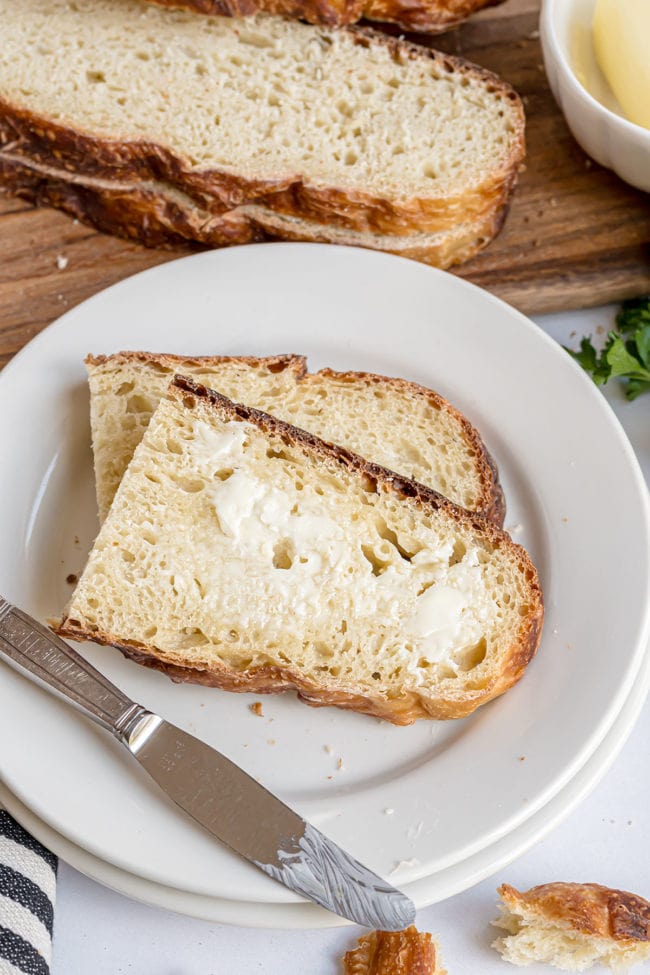
Cold Room Temp Proofing/Warming Techniques
When your kitchen is on the cooler side during the winter season, or you prefer arctic temps during the warmer ones, you’ll need to give your sourdough bread a little TLC. Try one of the following options to create the ideal 75º to 85ºF environment during the proofing stage.
- Instant Pot: Use the yogurt setting on your Instant Pot (not the “warm” setting).
- Oven Proofing: Turn to 85ºF if you have a proof setting.
- Oven Light: Put the sourdough in the oven and keep the light on with the door shut.
- Oven Cheat: When the only option is a minimum warmth level, turn the oven off when it reaches ~120ºF. Then, place the sourdough bread in it with the heat off.
- Refrigerator Top: This area is great for gentle warming if the residual heat from the appliance gets trapped or dissipates slowly.
- Sunny Room: Use a warm, sunlit room if you have one (critter-free and) available.
These simple options provide alternative proofing methods for your sourdough. Choose the one that best suits your kitchen and schedule!
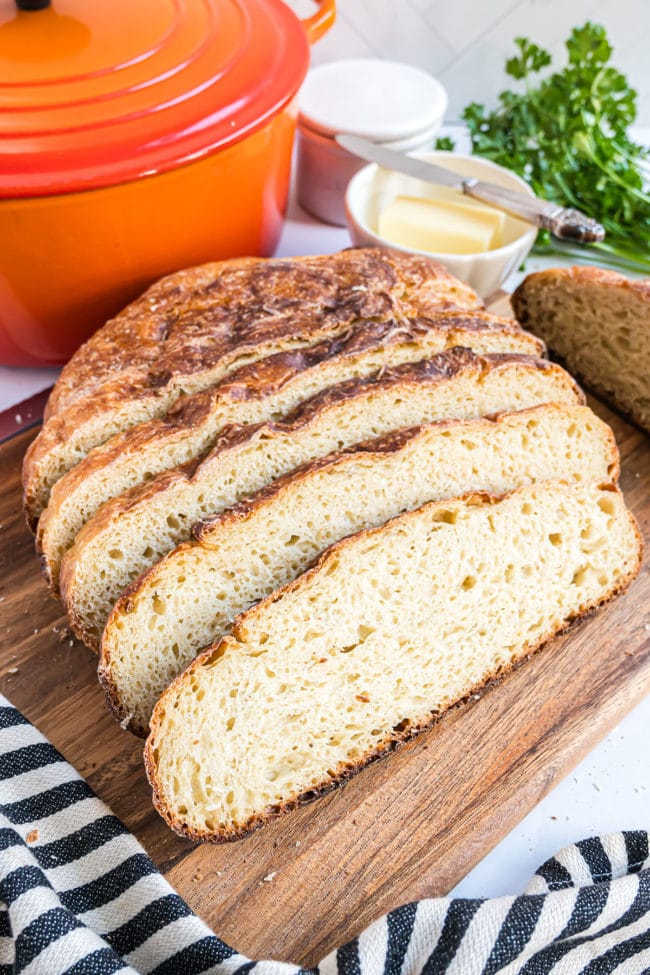
How To Store Dutch Oven Bread
After baking sourdough bread in a Dutch oven, it’s essential to allow it to cool completely on a wire rack. Once cooled, store sourdough bread in a paper bakery bag or wrap it in a clean kitchen towel so it can breathe and maintain its crust.
Avoid using plastic wrap or containers, as they trap moisture and make the crust soggy. Ideally, consume the bread within a few days for the best texture and flavor.
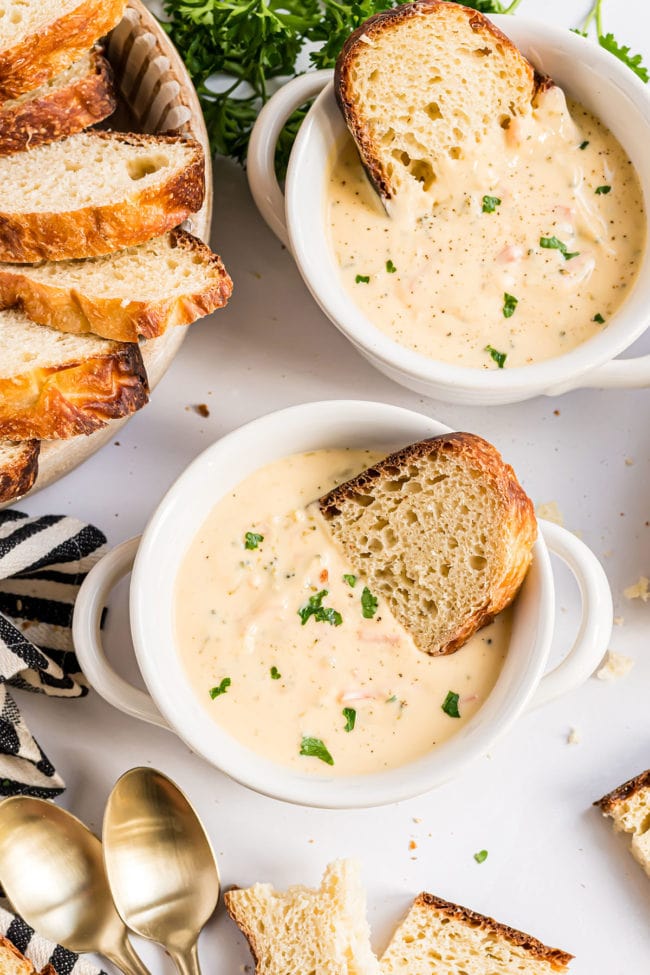
FAQs
Dutch ovens create a steamy environment for a crispier crust and airier crumb. The thick cast iron walls distribute heat evenly, leading to consistent baking and a deeper flavor profile.
Quick yeast, also called instant yeast, skips the blooming step and mixes directly with dry ingredients. It rises faster than active dry yeast, making it ideal for a no-knead sourdough bread recipe.
Using too much flour in the no-knead bread recipe can lead to a denser texture. It’s important to measure the flour accurately (a digital kitchen scale makes it foolproof) and consider the dough’s hydration level (amount of water) for optimal results.
The right hydration level (amount of water) is crucial in bread-making. Water helps to control dough consistency and can impact factors like crumb structure and crust formation. It’s an essential aspect of achieving the desired characteristics in your homemade bread.
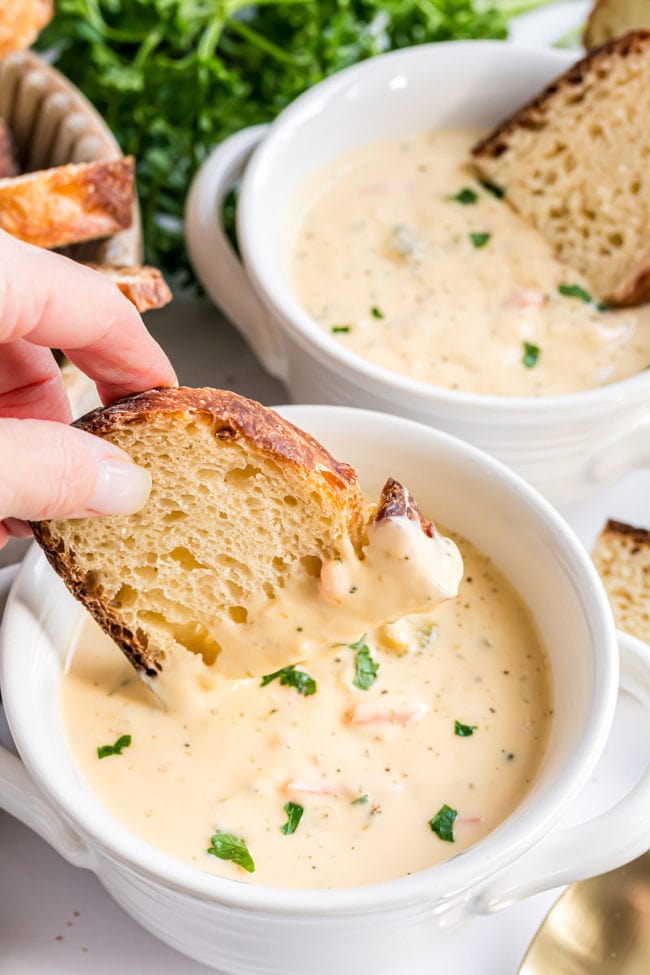
Serving Suggestions
Easy no-knead sourdough bread is the ultimate homemade rustic-style crusty bread recipe! The best part? It’s foolproof, and takes minimal effort, even novice bakers can make an artisan boule for a hearty addition to any one of these delicious options:
- Serve this sourdough dutch-oven bread recipe with your favorite soup – like Roasted Tomato Soup, French Onion Soup and Butternut Squash Soup.
- Toast and dip it in Spinach Artichoke Dip or with Wedge Salad Crostini!
- Spread Homemade Cinnamon Honey Butter, Strawberry Freezer Jam or Pumpkin Butter on a slice of dutch oven bread for a tasty treat.
- A loaf of No-knead Sourdough bread is always delightful alongside a favorite pasta dish, such as Pizza Pasta Bake, Three Cheese Baked Mostaccioli, and Fettuccine Alfredo.
- Use leftover sourdough bread for homemade croutons!!
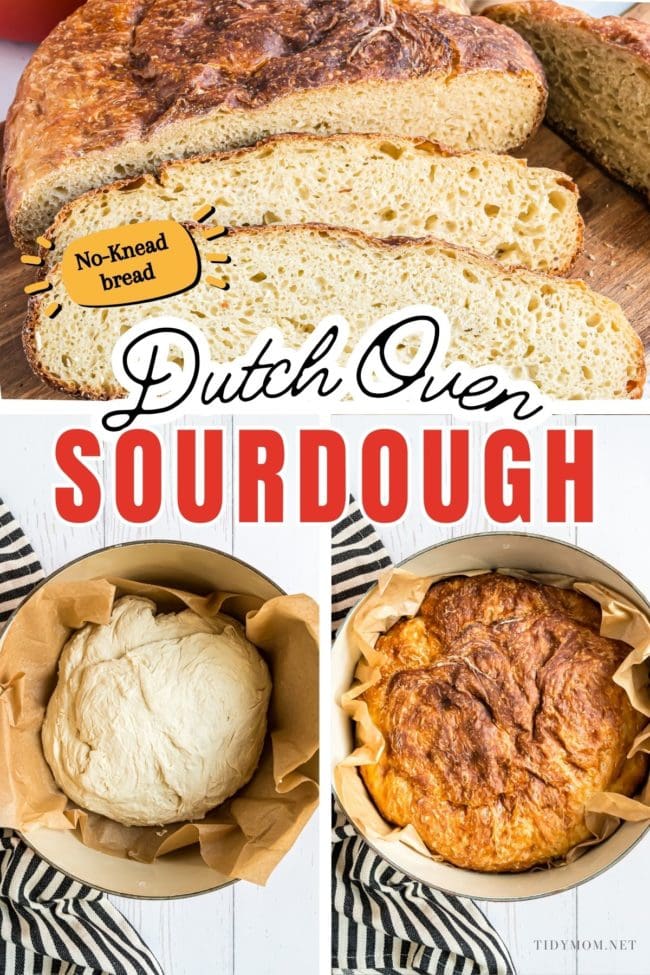
Like This Recipe?
I’d love to hear what you think! Leave a review below and let me know how you liked the recipe!
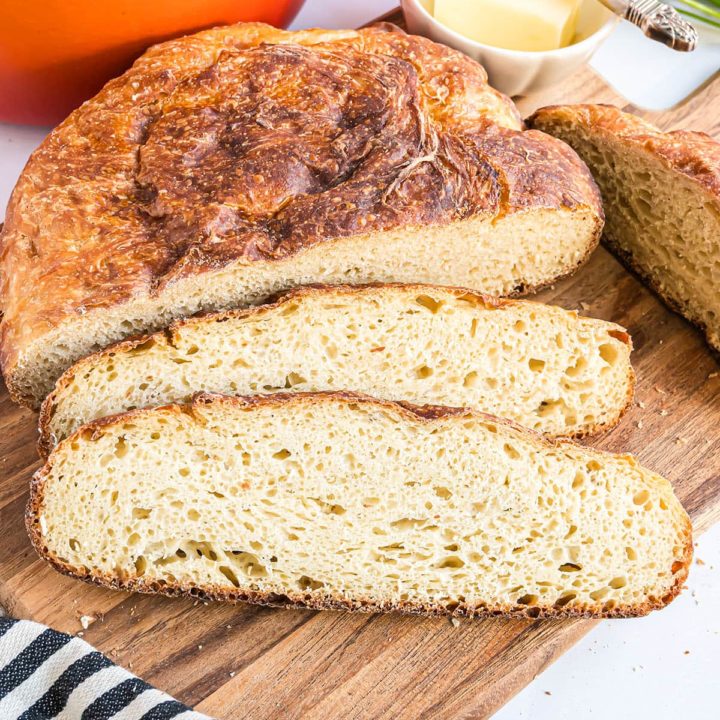
Sourdough No Knead Dutch Oven Bread
An easy way to make artisan-style crusty bread at home! Very little effort is needed and it’s foolproof! Just 5 minutes of mixing and you can have delicious homemade bread in just 4-5 hours!
Ingredients
- 5 cups all-purpose flour ( 600g)
- 2 teaspoons quick rising yeast
- 1 tablespoon kosher salt
- 1 1/2 cups warm water
- 1 cup plain greek yogurt
- 1 tablespoon honey
Instructions
- In a big bowl, stir together the yeast, flour, and salt. Add water, yogurt, and honey and using a wooden spoon mix until well incorporated. Cover the bowl with plastic wrap and let sit at room temperature for 2 hours or until it doubles in size.
- Line a 4-quart or larger Dutch oven with parchment paper. Dust your hands and work surface with flour and scrape the dough out of the bowl (dough will be loose and sticky). With your floured hands, roughly shape dough into a ball. Place dough ball into parchment lined Dutch oven. Let it sit on counter to rise 1 hour.
- Preheat oven to 475°. Place rack in center of oven. Cover the Dutch oven with lid and bake for 20-25 minutes. Carefully remove the hot lid and continue baking another 20-30 minutes, or until the bread is a deep golden brown.
- Remove the bread from the Dutch oven and let it cool completely on a rack for at least 1 hour before slicing.
Notes
- for more of a sourdough flavor, let the dough rise in the refrigerator overnight.
- the smaller the dutch oven, the more the bread will rise upwards.
- check to make sure your yeast has not expired
Nutrition Information:
Yield: 12 Serving Size: 1Amount Per Serving: Calories: 208Total Fat: 1gSaturated Fat: 0gTrans Fat: 0gUnsaturated Fat: 0gCholesterol: 1mgSodium: 324mgCarbohydrates: 42gFiber: 2gSugar: 2gProtein: 8g
Nutrition information is estimated based on the ingredients and cooking instructions as described in each recipe and is intended to be used for informational purposes only. Please note that nutrition details may vary based on methods of preparation, origin, and freshness of ingredients used and are just estimates. We encourage, especially if these numbers are important to you, to calculate these on your own for most accurate results.
Originally posted in November 2017. UPDATED January 2024. We spiffed up this post with more information and new photos. No change to the recipe.
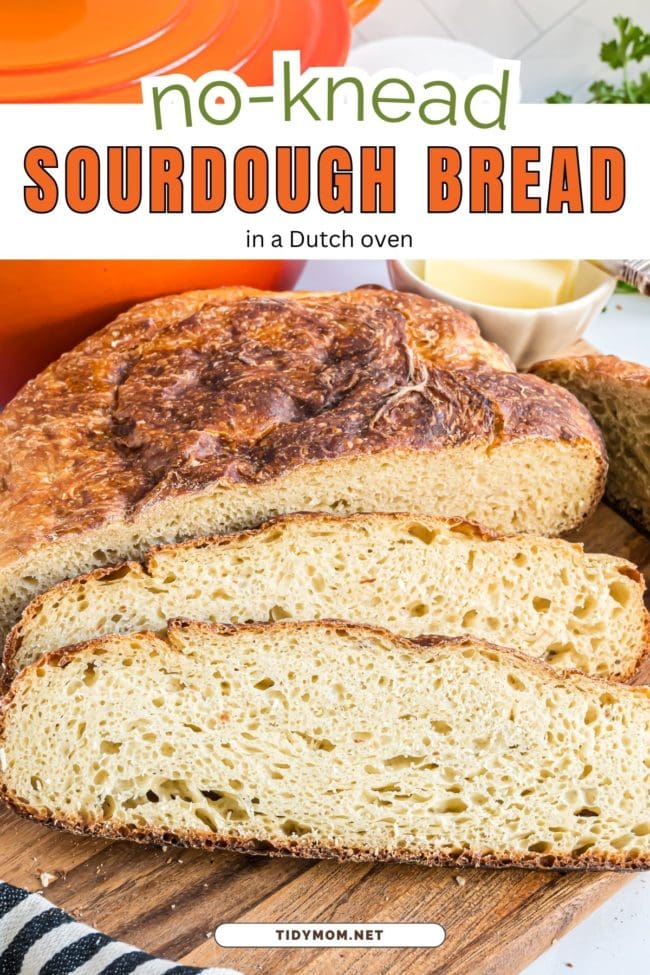

Tidymom is a participant in the amazon services llc associates program, an affiliate advertising program designed to provide a means for sites to earn advertising fees by advertising and linking to Amazon.com.
Please respect my work, recipes and photographs. If you do use a recipe in your own writing, please give proper credit and link back to the original post.

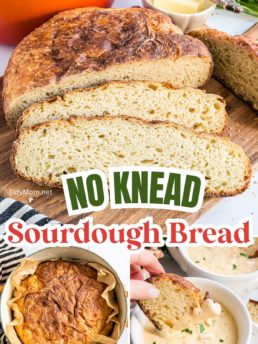

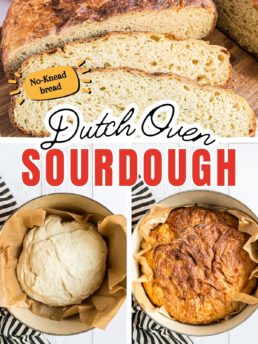
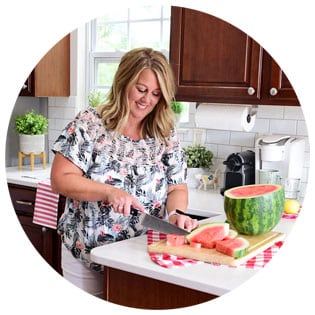
Hi Cheryl
You were one of the first blogs I ever read. Now several years later reading about your empty nest status. Our youngest is in highschool and our daughter is now working (and moved out this summer) and our middle is a freshman in college outside of Minneapolis.
It was a great post! I do a few sponsored posts and yours was a great way to weave the soup with the artisan bread. Loved it!
laura
thanks so much Laura!! They grow up too fast don’t they?!
We love having bread with dinner, especially with soups!! I need to try this. It’s looks amazing!
This bread is EVERYTHING! Anything that is hands off and full of carby goodness is a winner in my book.
I would love a big bowl of soup and some of that delicious looking bread right now!
I just discovered these bread recipes! I have made a plain one and one with cranberries and walnuts (so good). This recipe is a bit different than the others with the yogurt in it. Does that give it more of a sour dough taste? Love sour dough! Thank you – pinned to try over the holidays. Happy Thanksgiving!
This bread is a delight! And there’s nothing better to eat with a big bowl of soup. Nice!
Love a good crusty homemade bread with a bowl of soup! I definitely need to make this soon. 🙂
No kneading! I am always in for that!
I’d like to make this for Thanksgiving dinner, but as rolls instead of bread. Is that possible? Also, I don’t have a cast iron Dutch oven, only a heavy cast aluminum one that I think is good in the oven up to 400, maybe 450 (handles). Does the bread really have to bake at such a high temp?
Thanks.
I’m thinking just use a spoon and scoop into a muffin pan or maybe even a popover pan—greased as I doubt there’s a way to use parchment paper—and let rise an bake as per usual covering for first half may not be possible either. Anyway, I’m always tweaking recipes. ??
I love having a slice of good bread with my soup that I make homemade. What temperature is the warm water supposed to be
Thanks, Beverly
Is the yeast mixed before adding it or just add the powder?
you just stir together the yeast, flour, and salt then add water, yogurt, and honey and using a wooden spoon mix until well incorporated.